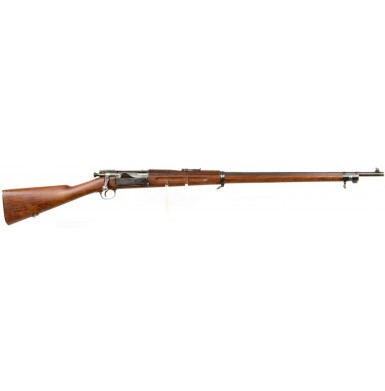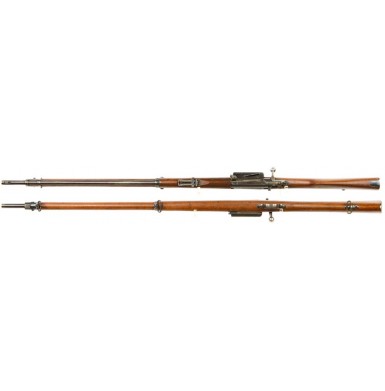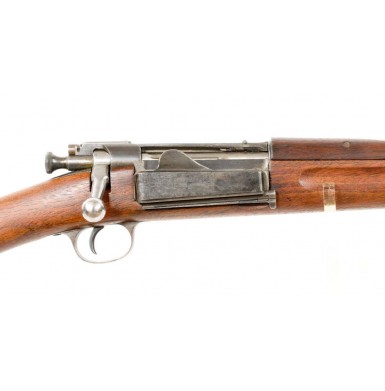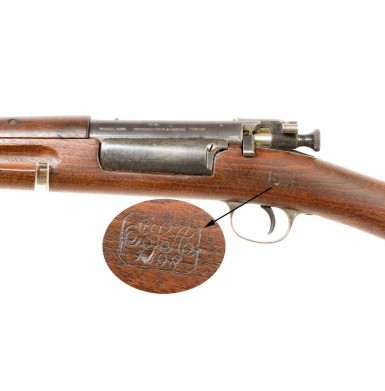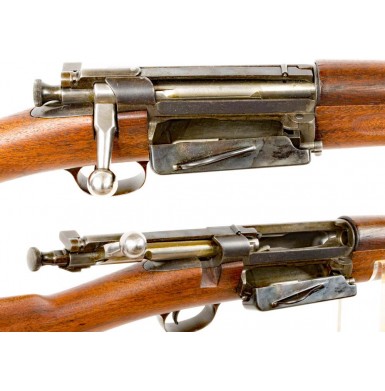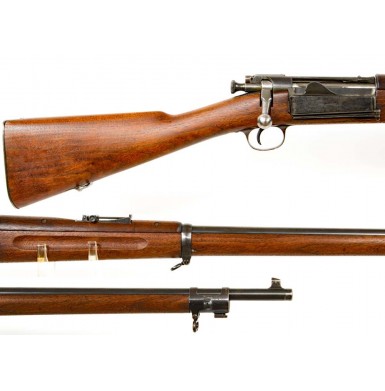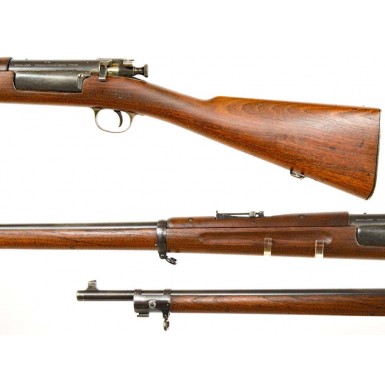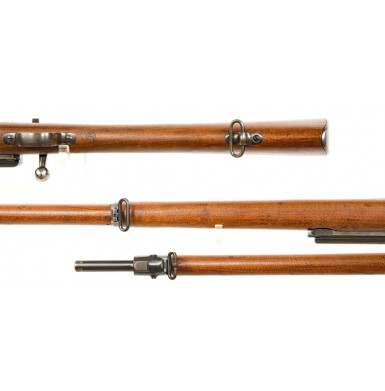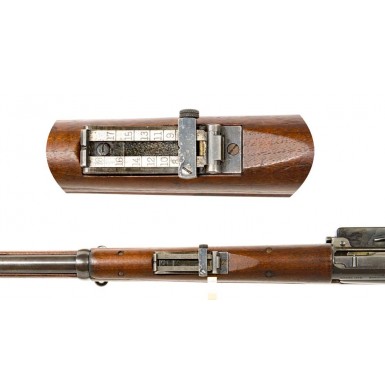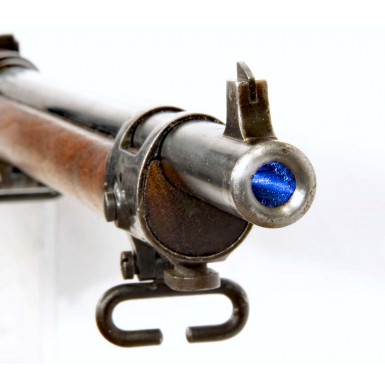The latter part of the 19th century was a time of significant advancement in small arms design. The Crimean War of the 1850s had shown the world that the day of the smoothbore infantry musket was over, and that rifled arms issued universally was the wave of the future. A decade later, the American Civil War proved that the era of the muzzleloading percussion rifle musket was already at an end, and that metallic cartridge breech loaders were going to rule the battlefield in the immediate future. Around the world, the various nations all looked for efficient methods to alter the huge stocks of muzzleloading arms to metallic cartridge breech loaders. By the early 1870s, nearly every nation was arming their front line troops with some form of breechloading, single shot metallic cartridge firearm. These new rifles were typically smaller bore than their muzzleloading predecessors, with the US military adopting .45 caliber bores, and most of the European nations moving towards a similarly sized cartridge that was nominally 11mm-12mm in diameter. However, the advantage of repeating arms in combat had been proven during the American Civil War. Although the black powder cartridges delivered by the various lever action repeaters were ballistically inferior to the higher powered cartridges available single shot, breechloading actions, the increased firepower had been proven to be decisive in some situations. By the end of the 1870s most of the world militaries were at least experimenting with bolt action breechloaders and by the mid-1880s, they were starting to bring bolt action repeating rifles into service.
Many of these new bolt action, repeating rifles were of even smaller caliber than the rifles of just a decade earlier. In Europe, calibers between 7.5mm and 8mm were the wave the future; nominally .30 caliber. Research had proven that the smaller caliber bullets with longer bearing surfaces, pushed to higher velocities, provided better down range ballistics and accuracy out to distances previously only available to the finest grade target rifles. In 1886, the French stunned the world with their introduction of a new “smokeless” powder propellant, which it utilized in the cartridge for their newly adopted Model 1886 8mm Lebel Rifle. This was a contributing factor to a US 1887 Chief of Ordnance Report that concluded that reduced bore cartridges were superior ballistically. In 1888, Springfield Arsenal started to experiment with a .30 caliber service rifle based upon the M1888 Trapdoor Rifle. However, the board reported the lack of suitable propellant to obtain the necessary pressures and velocities were severely hampering the experimentation. Black powder was not capable of doing the job required and the French smokeless powder formula was a closely guarded secret. As the other European powers began to adopt their own variant of smokeless powder, the United States found themselves slipping further behind in the race to modernize small arms. Further Ordnance Department experimentation during 1889 revealed that the 7.7mm Rubin cartridge, utilized in the repeating magazine rifles by Rubin and Shulhoff, was significantly superior to the US .45-70 cartridge. In an attempt to catch up with the militaries in the rest of the modern world, the US Ordnance Department followed its time-honored tradition of establishing a board of officers to “consider and recommend a suitable magazine system for riels and carbines for military service.” The board was authorized on November 24, 1890 and delivered its report slightly more than a eighteen months later in August of 1892. During the preceding months the board had overseen the testing of some fifty-three different repeating rifles. Among those rifles tested were the military rifles of such countries as Austria, France, Russia, Germany, Portugal, Japan, Great Britain, Switzerland and Norway, just to name a few. These guns included such well known designs as the German Model 1888 “Commission Rifle”, the Portuguese Kropatschek, the Japanese Murata, the French Berthier, the Russian Model 1891 Nagant, the English Lee-Speed and the Danish Krag-Jorgenson. Additionally, many submissions were provided by various designers that were not currently in use by any military. Two additional Berthier designs were tested, along with five Mauser variants, three Lee designs, five additional Krag-Jorgenson variants, as well as designs from relatively unknown developers such as Bruce, Ford, Larsen, Blake, Kelton, Russell-Livermore. Three .30 Springfield submissions were also tested. The testing was vigorous and extensive. The rifles were tested for accuracy, speed and ease of operation, durability, ease of disassembly and maintenance, as well as resistance to all forms of harsh abuse; ranging from dirt and dust to rust and corrosion. After these exhaustive tests, submission #28, Krag-Jorgenson #5 was selected as the winner.
The board had gone into the testing with some certain predetermined features that they wanted to see in the new rifle. It was to be a small bore, magazine fed rifle that featured a magazine cut-off that would allow the rifle to be used a single shot firearm in most situations. Without specifying it, the general consensus was that the rifle was going to be a bolt action design. In the view of the Ordnance Department, this would conserve ammunition and would save the cartridges in the magazine for emergency use. The board was also predisposed to select a rifle that allowed the magazine to be “topped off”. As many of the European designs used stripper clips to load a fixed magazine, those designs were less likely to be selected. The Krag-Jorgenson design incorporated a side mounted box magazine that could be opened and topped off while the rifle was in operation. The rifle included the necessary magazine cut off and performed well in all of the testing. However, Congress was unhappy that the design was a foreign one and in conjunction with appropriating $400,000 to start the process of producing a new US magazine rifle, required that additional testing be done of American designs. To that end, an additional board was convened in the Spring of 1893 to evaluate fourteen American designs, which include submissions from Lee, Durst, Russell-Livermore, Spencer-Lee, White, Hampden, Blake and Savage. By mid-May the board had completed its testing of these rifles and came to the original conclusion; the winner was the Krag-Jorgenson design.
The Krag-Jorgenson was designed by Colonel Ole Hermann Johannes Krag of the Norwegian Army and Erik Jorgenson, a gunsmith who was working at the Kongsberg Arms Manufactory. The design was first adopted by Denmark in 1889, chambered in 8x58R. The United States adopted the design next in 1892, chambered in .30 US Government, better known today as .30-40 Krag. The rifle was also adopted by Norway the following year, chambered for a 6.5mm cartridge.
In America, the production versions of the Krag rifle was designated as the Model 1892, with the first completed rifles being delivered in 1894. Like most military rifles, the Krag went through a series of modernizations and improvements during its production life. These improvements resulted in three distinct models of the service rifle being produced between 1892 and 1903; the M1892, M1896 and M1898. Additionally, four models of carbine were produced (M1892, M1896, M1898 and M1899), as well as some limited production specialty arms like the M1898 Gallery Practice Rifle, M1896 Cadet Rifle, M1898/99 Constabulary Carbine, an experimental 26” barreled rifle and both an experimental rifle and carbine produced with Parkhurst Devices. A total of 479,883 Krag models of all variations would be produced during the eleven years that the arms were in production with 324,238 being rifles. Throughout production the rifle was produced with a 30”, .30 caliber blued barrel, rifled with four grooves with a 1:10” twist. The barrel was retained by two barrel bands, with sling swivels mounted on the lower band and in the toe of the rifle and a stacking swivel mounted under the upper barrel band. The furniture was blued as well, with the receiver casehardened in dull blue-black colors and the bolt left in the white. The rifle was stocked in walnut, was a bolt action repeater with a side loading box magazine that held five rounds. The rifle had an overall length of 48.9” and weighed in at 9.187 pounds, without the bayonet. A lug under the upper barrel band allowed the mounting of a knife bayonet. As originally produced, the Model 1892 had a solid upper barrel band and a stock that was drilled for a brass tipped cleaning rod. This design was soon abandoned, and a double strapped upper band was adopted, the cleaning rod eliminated, and a butt trap added to the rifle for the storage of a three-piece cleaning rod. As the rifles began to be issued and saw use in the field, small changes and alterations began to be adopted. As was the usual practice at the time, many of the rifles in storage at US ordnance facilities were updated as new features were adopted. This means that original, early production M1892 rifles with cleaning rods are very rare today as most were updated while in service. After enough improvements and modifications were adopted, a new “model” was designated. In 1896, such was the case, as nearly a page full of modifications had taken place from the initial M1892 Rifles. While most of the changes were minor machining and mechanical changes that are not immediately obvious, some are rather visible. Most notable of those were the crowned muzzle (originally the M1898 has a flat muzzle), a thicker buttplate with a curved toe and a trap for the cleaning rod, a thicker wrist for the stock and a new pattern of rear sight. Similarly, another series of mostly minor engineering changes were incorporated into the Model 1896 Rifle, which resulted in the M1898. As with the M1892, most of the older rifles in storage were brought up to specifications as much a possible with the addition of the appropriate new parts. The one part which the Ordnance Department never seemed to be satisfied with was the rear sight. In all, five models of rear sight would be used on the Krag Rifles (four on the carbines), and the rifle sights often had sub-variations. The rifle sighs would be designated as the M1892, M1896, M1898, M1901 and M1902. The M1896 would have two variations in the way the ladder was graduated, the M1901 would have four variations and the M1902 would have five variations.
As noted, some 324,238 Krag rifles were produced at Springfield between 1892 and 1903, with deliveries beginning in 1894. The rifle would be our standard infantry rifle through the turn of the century and would see service during the Spanish-American War, The Philippine Insurrection, as well as the numerous small “banana wars” that we were involved in during the decades following the Spanish-American War. According to Springfield Armory production figures, those Krags with serial numbers under 162,000 were manufactured prior to December 31, 1898, which means these arms are “antique” and not considered firearms under Federal Law. During calendar year 1898, serialization of Krag long arms started at 91,000. In that year 23,220 Model 1896 Rifles were produced, 39,164 Model 1898 Rifles were manufactured, 5,001 Model 1898 Carbines were manufactured, as were 5,150 Model 1899 Carbines.
Offered here is a FINE condition ANTIQUE US Model 1898 Krag Rifle. The rifle was produced during the second half of 1898. The first deliveries of the M1898 Rifle were made on July 8, 1898, with 39,164 being delivered before the end of the year; an average of about 1,650 rifles per week. The rifle is clearly marked on the upper left side of the receiver:
U.S.
MODEL 1898. SPRINGFIELD ARMORY 138697
The serial number clearly places the rifle in the “antique” range, with manufacture prior to the end of 1898. The stock is crisply marked with a clear, script JSA cartouche over the date 1898 in a rectangular box with angled corners. This is the mark of Springfield Armory inspector Joseph S. Adams, who succeeded Springfield’s Master Armorer Samuel W. Porter in 1894, assuming Porter’s responsibilities. However, as the Federal Government had decided to eliminate the positional title of “Master Armorer”, Adams never assumed that title, only the role. The expected fancy P firing proof is present in a circle behind the triggerguard, as well as a small J stock inspection mark. All markings remain clear, crisp and fully legible. The rifle retains about 50% of the original blue, which is thinning and fading, particularly on the back half of the exposed barrel, closest to the handguard. The furniture retains a similar amount of blue as well. The receiver retains about 80% thinning and dulling case coloring, with the typical dull blue-black color of Krag receivers, showing some dark mottling but not the vivid colors of other 19th century case colored arms. The extractor shows about 30%+ bright fire blue, again with thinning and fading. The bolt remains mostly bright with some dulling and minor oxidation. The rifle is mechanically fine and like all Krags, the bolt operates very smoothly. The magazine opens and closes crisply and tightly and the bore rates about VERY FINE. The bore is bright with crisp rifling and shows only some minor frosting along its length. The metal of the rifle is almost entirely smooth, with no pitting present. There is some minute pinpricking around the receiver and magazine, but this is barely worth mentioning. The rifle retains its original Model 1896 Type II rear sight, the sight that was in use when the M1898 was introduced. The Type II sight was re-graduated from the Type I to change the point of aim-point of impact of the ammunition so the rifle would tend to shoot low, rather than high at long range. The sight is graduated to 1,800 yards. Towards the end of 1898, the new M1898 sight was adopted with a different base and eye piece, graduated to 2,000 yards. The rifle retains its original front sight and blade, both sling swivels and the stacking swivel, and the bayonet lug under the front barrel band. The stock of the rifle is in VERY FINE to NEAR EXCELLENT condition. The wood remains extremely crisp throughout and retains some of its original feathery grain. As noted, the stock has a clear and crisp cartouche at the wrist and clear inspection marks behind the triggerguard. The stock is solid, complete and full-length with no breaks or repairs. The stock does show some lightly scattered minor handling marks and small dings, the most noticeable being a small ding in the middle of the first “8” in the date “1898” in the cartouche. The only other condition issue worth mentioning are a couple of very tiny, surface grain cracks at the top rear of the handguard. These are barely noticeable and are only about ½” in length but are mentioned for exactness.
Overall, this is really fine and crisp example of a complete and correct Antique US M1898 Krag Rifle. This would be a fine addition to any collection of US marital arms, particularly as the Krag was the first small bore, bolt action, magazine fed repeating rifle to be adopted by the US military. The rifle is really in fine condition with clear marks and a fine bore and has nothing to apologize for. I am quite sure you will be very pleased adding this rifle to your collection.
SOLD


